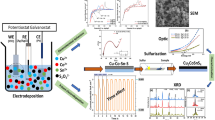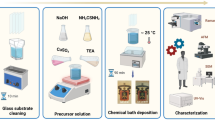Abstract
TiO2 powder and TiO2 thin film on the surface of glazed ceramic tile were prepared by sol-gel method. The influences of different doping Cr3+ concentration on the photocatalytic activity of TiO2 were discussed, UV-visible and X-ray diffraction analysis were used to test the performance of TiO2 powder and film. The results indicate that photocatalytic activity of doping Cr3+-TiO2 thin film is higher than that of powder, and the interaction between Cr3+-doped and substrate can greatly enhance the photocatalytic activity. The results of X-ray diffraction and photoabsorption show that the Cr3+-doped energy level in TiO2 is 0.62 eV high from the top of valence band, which belongs to the type of deep energy level doping. On the basis of the semiconductor energy level theory and Cr3+ dopant energy level, the semiconductor energy level model of Cr3+ in TiO2 powder and thin film were established, and the doping mechanisms of Cr3+-doped in TiO2 powder and thin film were analyzed.
Similar content being viewed by others
References
Carey J H, Lawrence J, Tosine H M. Photodechlorination of PCB’S in the presence of titanium dioxide in aqueous suspensions [J]. Bull Environ Contam Toxical, 1976, 16: 697–701.
Goswami D Y. A review of engineering development of aqueous phase solar photocatalytic detoxification and disinfection processes[J]. Journal of Solar Engery Engineering, 1997, 119(3): 101–107.
LI Xiao-ping, XU Bao-kun, LIU Guo-fan, et al. The research and development of photocatalytic degradation of organic contaminant over nanosized TiO2 in water [J]. Function Material, 1999, 30(3): 242–247.
Hoffmann M S, Martin S T, Choi W, et al. Environmental application of semiconductor photocatalysis[J]. Chem Rev, 1995, 95(1): 69–96.
Linsebigler A L. Photocatalysis on TiO2 surface: Principles, mechanisms and selected result[J]. Chem Rev, 1995, 95(3): 735–758.
Hagfeldt A, Gratzel M. Light-induced redox reactions in nanocrystalline systems [J]. Chem Rev, 1995, 95(1): 49–68.
Choi W, Termin A, Hoffmann M R. The role metal ion dopants in quantum-sized TiO2: correlation between photoreactivity and charge carrier recombination dynamics [J]. Phys Chem, 1994, 98(51): 13669–13679.
Sakata Y, Yamamoto T, Okazaki T, et al. Visible light response of titania photocatalyst containing copper ion [J]. Chem Lett, 1998, (12): 1253–1254.
Vamathevan V, Tes H, Amal R, et al. Effects of Fe3+ and Ag+ ions on the photocatalytic degradation of sucrose in water[J]. The Catal Today, 2001, 68(1–3): 201–208.
ZHANG Feng, LI Qing-lin, YANG Jian-jun, et al. Study of visible spectral sensitization of nanocrystalline TiO2 photocatalyst[J]. Chinese Journal of Catalysis, 1999, 20(3): 329–332.
WANG Wei-wei, ZHANG Zhi-kun. Doping mechanism of TiO2 with transitional metal ions and there effects on light absorption characteristics[J]. Journal of Qingdao University of Science and Technology, 2003, 20(2): 102–104.
YU Xiang-yang, CHENG Ji-jian. Photocatalytic activities of iron and chromium ion doped TiO2 films [J]. Journal of Inorganic Materials, 2001, 16(4): 742–746.
HE Chao, YU Yun, ZHOU Cai-hua, et al. Influence Ag additive on the microstructure of TiO2 powders [J]. Journal of Inorganic Materials, 2003, 18(2): 457–464.
WANG Peng, CHEN Wen-xin, LIU Ying-liang, et al. Effect of rare earth ions doping on structure and photocatalytic activity of TiO2[J]. Journal of Jinan University(Natural Science), 2003, 24(5): 81–87.
Karl M A, Ginley D S. Simple method for estimating energy levels of solids[J]. J Vac Sci Technol, 1979, 16(4): 1042–1044.
LIU En-ke, ZHU Bing-sheng, LUO Jing-sheng, et al. Semiconductor Physics[M]. Beijing: Electronics Industry Press, 2004, 8: 220.
Tang H, Prasad K, Sanjines R, et al. Electrical and optical properties of TiO2 anatase thin films[J]. J Appl Phys, 1994, 75(4): 2042–2046.
Milnes A G. Deep Impurities in Semiconductors[M]. Beijing: Science Press, 1981.
Lin L B, Mo S D, Lin D L. Electronic structure of rutile(TiO2)[J]. J Phys Chem Solids, 1993, 54(8): 907–912.
Fernandez A, Lassaletta G, Jimenez V M, et al. Preparation and characterization of TiO2 photocatalysis supported on various rigid supports (glass, quartz and stainless steal) comparative studies of photocatalytic activity in water purification[J]. Appl Catal B: Environ, 1995, 7(1–2): 49–63.
Bideau M, Claudel B, Duben C, et al. On the “immobilization” of titanium dioxide in the photocatalytic oxidation of spent water[J]. Photochem Photobiol A: Chem, 1995, 91(2): 137–144.
Author information
Authors and Affiliations
Corresponding author
Additional information
Foundation item: Project (20466001) supported by the National Natural Science Foundation of China
Rights and permissions
About this article
Cite this article
Chen, Jh., Wang, Xl. & Gong, Zq. Mechanism and behaviors of Cr3+-doped TiO2 . J Cent. South Univ. Technol. 12 (Suppl 1), 59–64 (2005). https://doi.org/10.1007/s11771-005-0372-7
Received:
Accepted:
Published:
Issue Date:
DOI: https://doi.org/10.1007/s11771-005-0372-7




